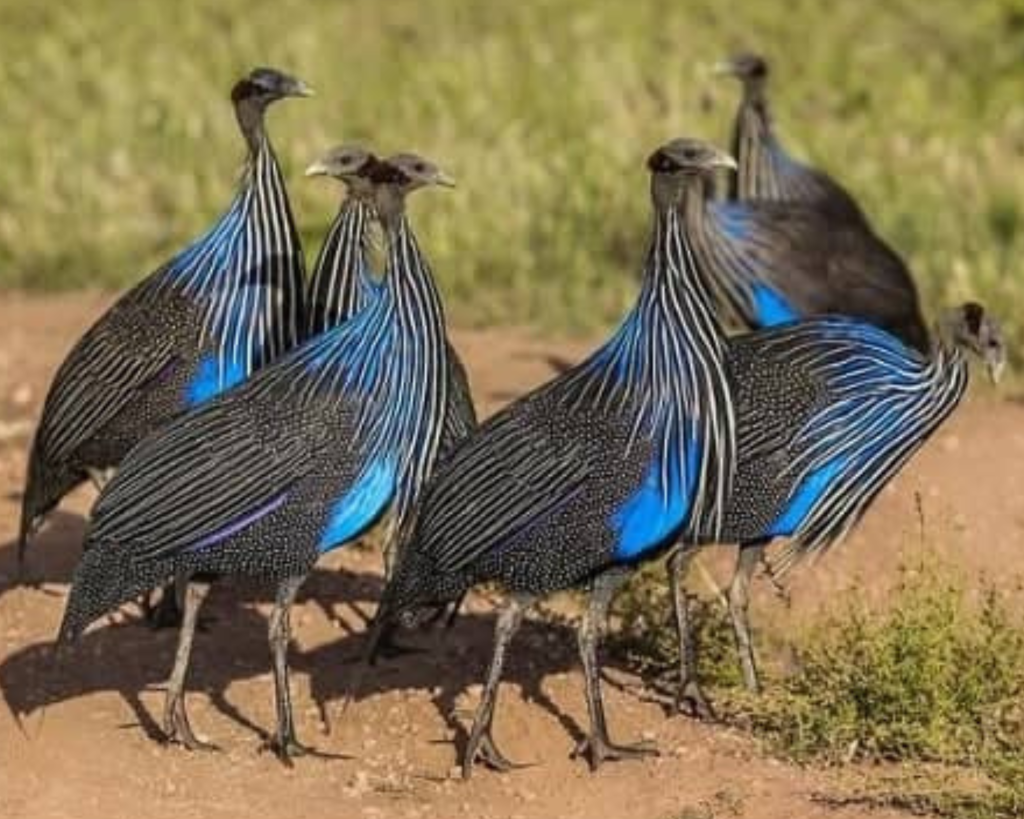These birds have brilliant blue bodies with striations of black and white, and their back feathers have a few little white spots here and there. They wear something like a horned helmet on top of their bare heads. The area around the head is colored vividly in blue, red, and yellow. The beak is dark and very small, while the eyes are a bright red. A row of teeny-tiny brown feathers runs along its head like a band. The males and females have relatively similar appearances, making it difficult to tell them apart.

Vulturine guineafowls procreate by the process of producing eggs. They prefer to live in arid regions, savannahs, and grasslands as their environment of choice. The usual size of one of their clutches is between three to 18 eggs. During one breeding season, each hen will lay approximately 40 eggs. After an incubation-period of 28 days, the chicks of this wild bird hatch into fully grown young that can take their first flight just a few short days after birth.

The population of vulturine guineafowl lives in flocks or groups, although each bird will perch independently on a tree branch. It’s not uncommon for them to get into fights among members of their groups over food or the loveliest trees to perch on. In addition to seeds, tubers, and roots, their food consists of grubs, tiny reptiles, rodents, and insects. It’s estimated that there are approximately 10,000 adults vulturine guineafowl over the entirety of the earth.

The only way for a vulturine guineafowl to have offspring is to mate with another member of its flock or clan. Only for the duration of one mating season do breeding partners remain together. Following copulation, the female deposits her eggs in a depression on the ground bordered by vegetation. After around 28 days of incubation, the chicks emerge from their eggs with a golden and brown coloration and are extremely fully formed. Within a short period, these young birds can take flight.

The vulturine guineafowl is often considered among the most colorful and stunningly beautiful birds in the world. A chick’s body is a dull blue color, and its feathers have brown and golden yellow shades. However, as they reach adulthood, it is when they transform into the beautiful creatures that they are. Because of its exquisite appearance, the vulturine guineafowl is frequently referred to as “the royal guineafowl.” They have long necks and long tails, and their heads do not have any hair.

They have long white and black feathers, and their breasts are a brilliant cobalt blue color. The feathers on their back are spotted with white, while the rest of their plumage is black. Their wings are round and very small, and their hackles are white. They have a band of small chestnut brown feathers and a blue-gray coloration on their heads. In addition, these birds have crimson eyes, and the beaks on their faces are small, dark, and pointed.

The loud ‘chink-chink-chink’ cries used for communication by vulturine guineafowl birds are similar to those used by helmet guineafowl, but their pitch is higher. These calls may be heard from a considerable distance, and the animals only produce them when they are in imminent-danger from a predator.

The tallest members of the guineafowl family are the vulturine guineafowl birds, which stand between 24 and 28 inches (61 and 71 centimeters) in height. Comparatively, the white-cheeked barbet is around one-fourth the size of these birds.

Because vulturine guineafowl birds are notorious for their aversion to flight, information regarding their top airspeed has been challenging. The only time it is known for them to fly is when they try to escape a potential threat or ascend to a higher perching position. They are, however, brisk runners, capable of attaining speeds of up to 22 miles per hour (35 kph).

The males of this species are referred to as roosters, while the females are referred to as hens. One of the few distinguishing characteristics between roosters and hens is that roosters tend to carry their heads higher than hens. Roosters and hens look remarkably identical.

The attitude of a typical vulturine guineafowl can be described as aggressive and violent. These birds frequently engage in violent conflict with other clan members to stake a claim to more desirable territory or food. Additionally, males have a particularly antagonistic relationship with hens. On the other hand, humans consider the vulturine guineafowl a reasonably tame bird, in contrast to the crested guineafowl, which is known to chase and attack humans.

The domestication of these creatures is on the rise, even though vulturine guineafowls are often classified as wild species and should be allowed to remain in their natural habitats. There is a lack of knowledge regarding the precise number held in captivity.














Could you go and check my other article also?










